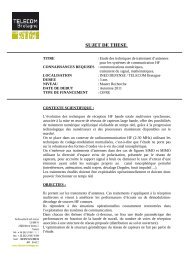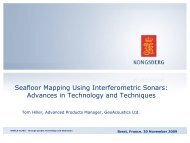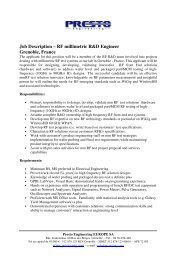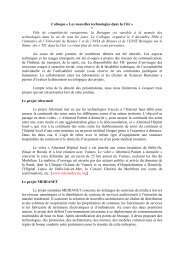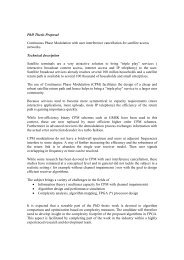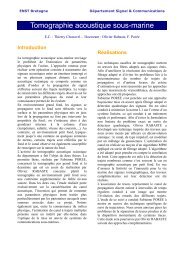Département Réseau, Sécurité et Multimédia Rapport d'Activités 2008
Département Réseau, Sécurité et Multimédia Rapport d'Activités 2008
Département Réseau, Sécurité et Multimédia Rapport d'Activités 2008
Create successful ePaper yourself
Turn your PDF publications into a flip-book with our unique Google optimized e-Paper software.
classes. In our simple study case, the wholeBE class is considered as a single virtual userof the next higher-QoS class. The resourcesallocated to this virtual user are then furtherdivided among the “real” users in that class.Thus, the resources guaranteed to every BEuser are not nil, since some amount of timeslots are reserved for the whole class. Duringcongestion, the degradation in service will beshared in proportion to the resources allocatedto the virtual user and all the BE users.The proposed scheme was evaluated bymeans of simulations using the well-known ns-2 tool. The results of out study, presented in[3], show that our scheme gives a lowprobability of unsatisfied QoS users in theoperable region, and prevents the starvation ofbest-effort users.Secondly, we have proposed an improvementof another existing QoS scheduler [4]. Whenallocating the available bandwidth, ourproposed mechanism, called Normalized RateGuarantee (NRG) scheduler [5], takes intoaccount the fact that QoS requirements (interms of minimum bandwidth) may vary fromone flow to the other. It tries to apportion lossrates in a fairer way during congestion.Another goal of NRG is to avoid thed<strong>et</strong>erioration of QoS when best-effort load isincreased.Performance evaluation of NRG was doneusing traces of a real reference video encodedusing the H.264 format. We verified theinsensitivity of the loss rate to the BE load, asshown in the figure below.The next figure shows how, with NRG, theaverage PSNR (peak signal-to-noise ratio) ofthe video is kept stable while the BE loadincreases. A similar improvement was alsoobserved in terms of the subjective videoquality, as assessed by means of the Pseudo-Subjective Quality Assessment (PSQA) m<strong>et</strong>ric.As can be seen in the two figures, the originalscheduler (labeled “hosein”) does not possesssuch desirable properties.ConclusionThe work presented above is related to theproblem of resource sharing in HSDPAn<strong>et</strong>works by means of MAC-level scheduling.We have introduced improvements to existingschedulers that can yield significantperformance benefits. Moreover, we haveproposed a way of sharing bandwidth thatavoids starvation of best-effort users, while atthe same time taking into account QoSconstraints of video streaming users.References[1] K.D. Singh. Improving Quality of Serviceand Resource Utilization for MultimediaStreaming over Third Generation MobileN<strong>et</strong>works. PhD thesis, Université de Rennes 1,December 2007.[2] T.E. Kolding. QoS-aware proportional fairpack<strong>et</strong> scheduling with Required ActivityD<strong>et</strong>ection. In Proceedings of IEEE VTC 2006Fall, Montréal, September 2006.[3] K.D. Singh, D. Ros, L. Toutain and C. Viho.Proportional Resource Partitioning over SharedWireless Links. In Proceedings of IEEE VTC2007 Fall, Baltimore, September 2007.[4] P. Hosein. QoS Control for WCDMA HighSpeed Pack<strong>et</strong> Data. In Proceedings of 4 th IEEEInternational Workshop on Mobile and WirelessCommunication N<strong>et</strong>work, Stockholm,September 2002.[5] K.D. Singh and D. Ros. Normalized RateGuarantee Scheduler for High Speed DownlinkPack<strong>et</strong> Access. In Proceedings of IEEEGLOBECOM, Washington, December 2007.20 Extract of Pracom’s Annual Report <strong>2008</strong>




